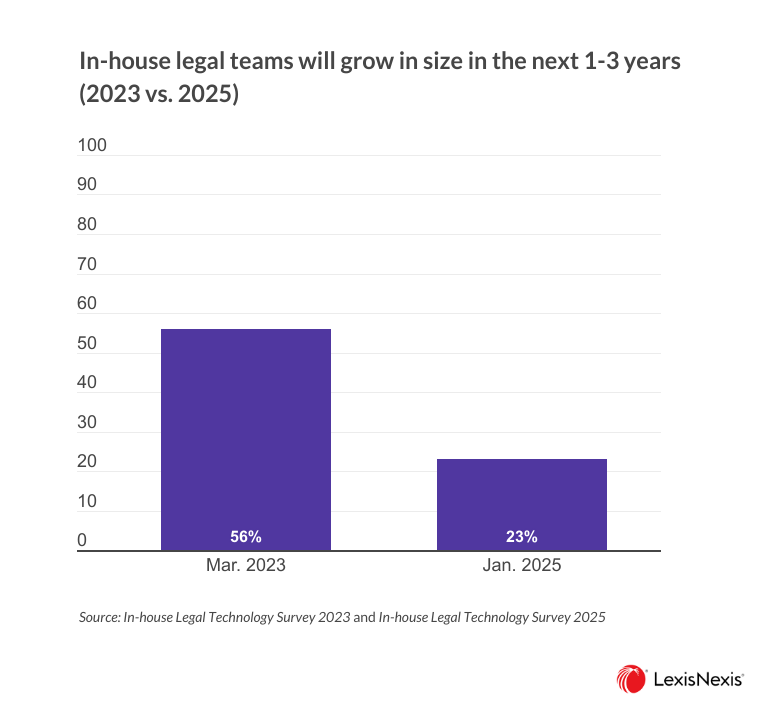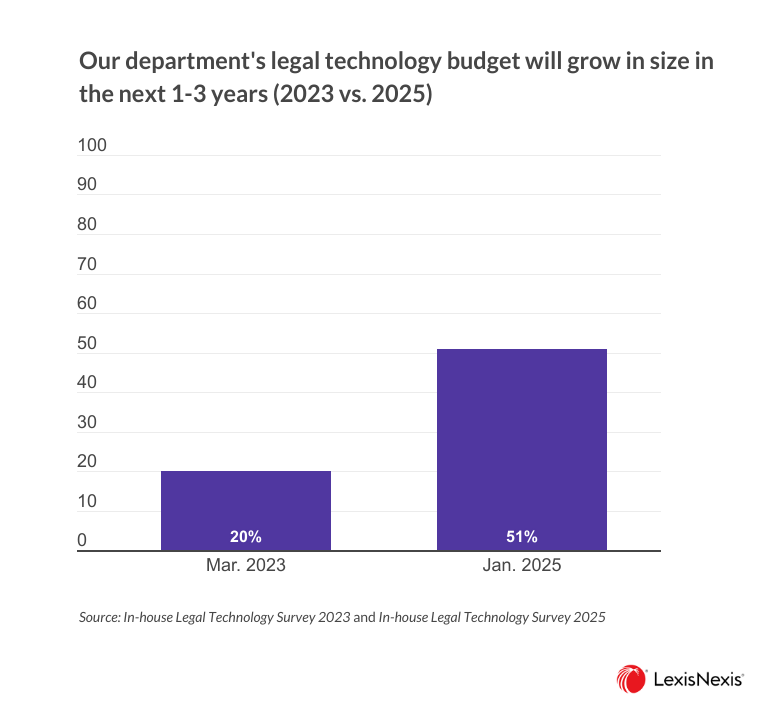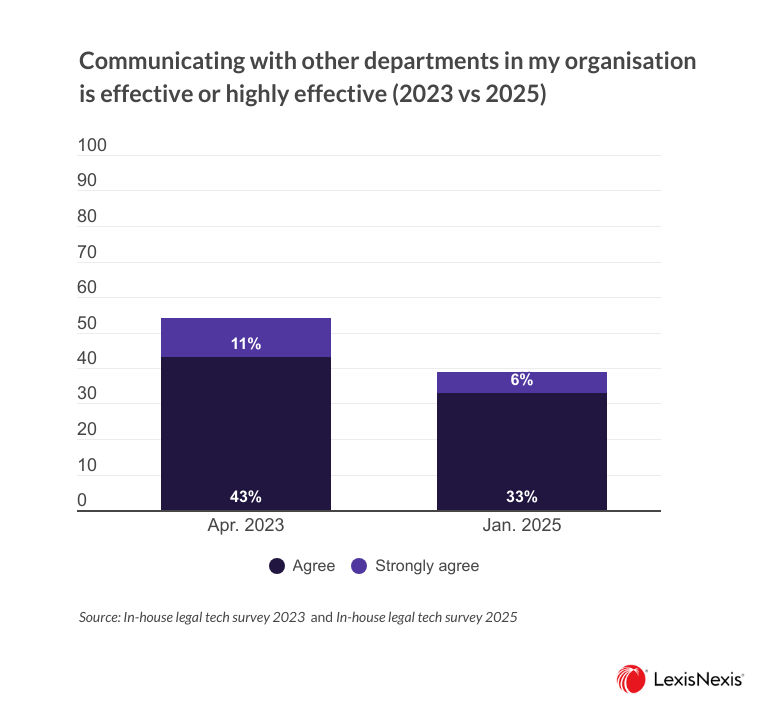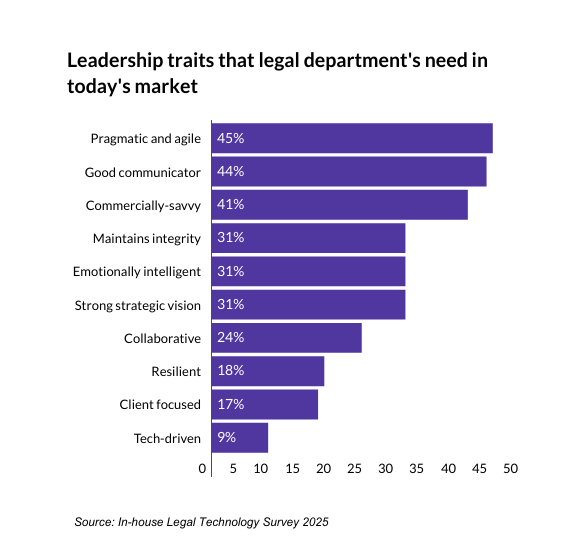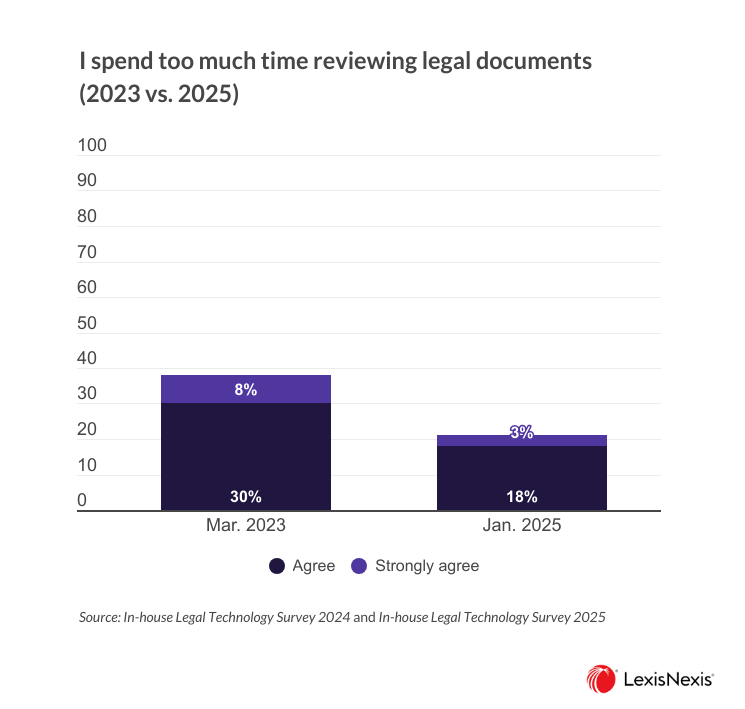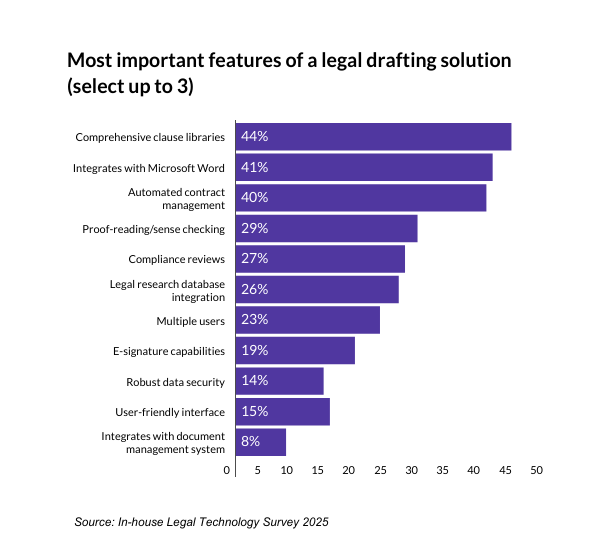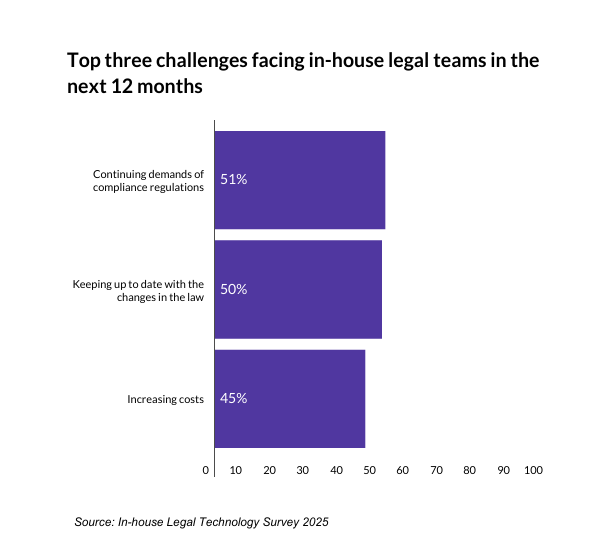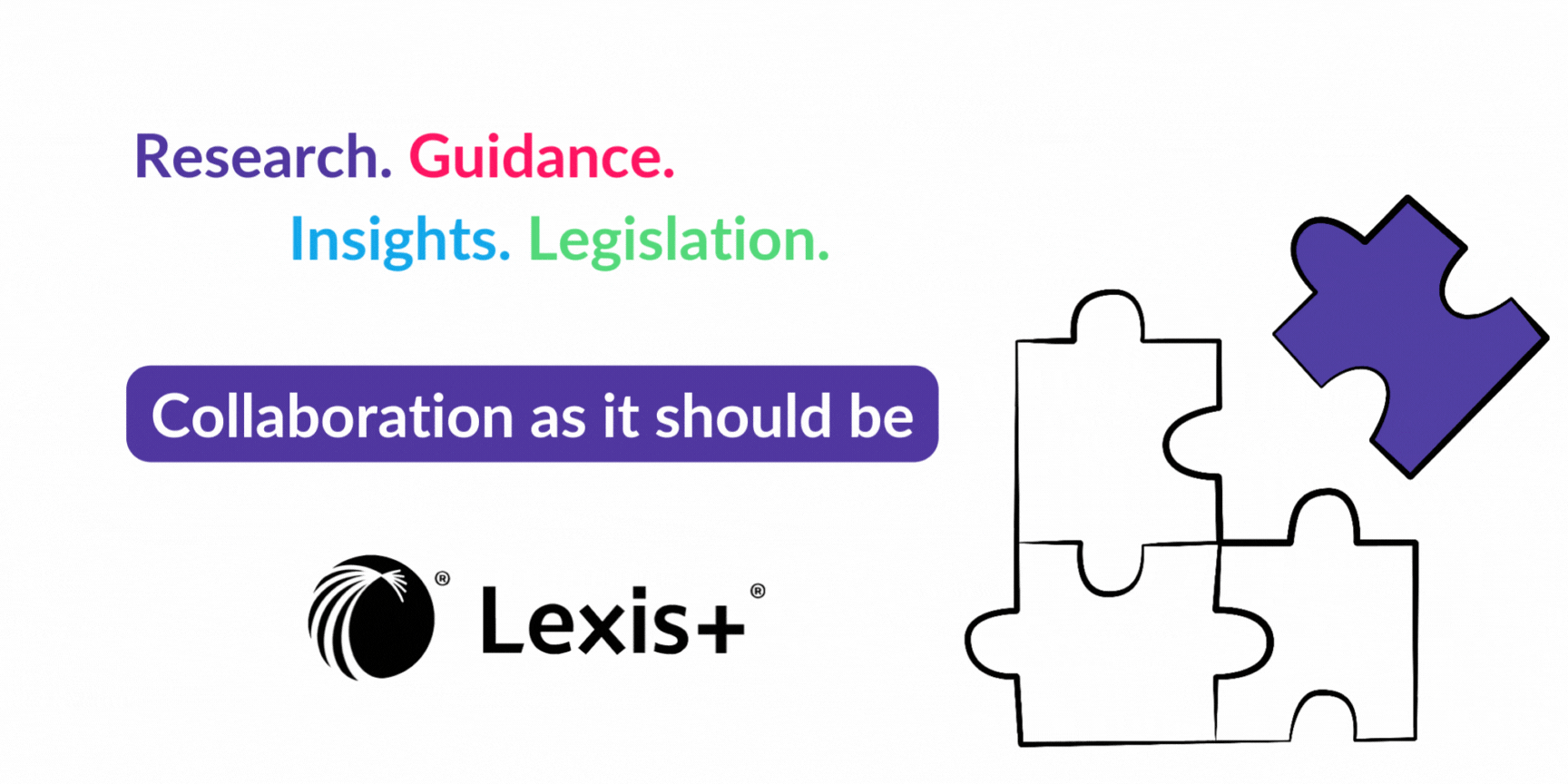In-house Legal Technology Report 2025
Legal minds unleashed: The creative revolution in corporate counsel

Attending scrums. Suggesting product features. Introducing new tech integrations.
Not the typical tasks you'd expect to see performed by an in-house legal counsel. But corporates face complex challenges, and need creative legal minds to help find innovative, ethical, legally-sound solutions.
Our In-house Legal Technology Survey 2025 reveals a demand for responsive, agile and creative legal minds that can help corporates navigate change and unlock new opportunities.
Our 2025 survey of 180+ in-house counsel found:
Legal teams will stop growing in size
Only a quarter (23%) of in-house counsel anticipate their teams will grow in size, down from more than half (56%) in 2023.
But they will scale up with new technology
51% said they expect technology budgets to increase this year, up from only 20% in 2023.
Departments have sped up the document review process
A quarter (21%) said they spend too much time reviewing legal documents, down from 38% in 2023.
Stakeholder relationships are a growing concern
Only two-in-five (39%) said communication with other departments is effective, a significant drop since half (54%) in 2023.
Corporates need creative legal counsel
Pragmatism and agility are the top traits in-house legal leaders need to be effective.

Making tech budgets count
Tech budgets are on the rise. But it’s smart execution that will set leaders apart.

In-house legal teams are shifting gears. With headcount growth slowing and workloads rising, they're turning to technology and creativity to meet growing demands and deliver more with less.
Our 2025 survey shows that legal departments are entering a new era of smarter scaling. While just 23% of in-house counsel expect their teams to grow, down from 56% in 2023, more than half (51%) anticipate an increase in their technology budgets this year.
The focus is no longer on building bigger teams, but on building more effective ones
Innovation isn’t just about tools. It’s about people driving them.
Luis de Freitas, Director & Managing Legal Counsel at Boston Consulting Group (BCG), underscores the importance of leadership buy-in when adopting tech.
Once leadership is invested, you can go to the team and share all the information, says de Freitas.
With executive backing, legal can embed tech like AI into core workflows, shifting from reactive support to strategic enabler.
Teams aren’t just buying tools, they’re building them. Temitayo (Ty) Ogunade at GWI is training AI-powered Slack chatbots to answer common legal questions, freeing up time and helping the wider business self-serve.
Meanwhile, Algolia's Corporate Counsel, Alex Love, uses generative AI not just for shortcuts, but for strategic ideation:
“My reflex now is to actually use generative AI and say, ‘Here’s the problem I’m having—please can you give me four or five ways to fix this.’”
At Palantir Technologies, Commercial Legal Lead Laura Dietschy is taking a bespoke approach. Her team uses retrieval-augmented generation to combine AI with internal data systems, tailoring outputs to the business’s real challenges.
"The core bit of our approach," she says, "is integrating the model with the organisation's information systems." She makes space for scaling efforts during quieter work cycles, showing that innovation needs not just budget, but dedicated time.
The bottom line? Legal teams are becoming technologists, connectors, and problem-solvers.
They’re blending legal expertise with cross-functional thinking to drive business value—often in very visible ways. Whether it’s automating document review, enabling instant legal FAQs, or contributing to product scrums, these forward-thinking teams are finding creative ways to stretch every tech dollar—and redefine their role in the process.
Legal technology budgets are expected to increase this year
Connecting with stakeholders through creativity
Communicating with other departments is a growing concern. Collaborating could help fill the gap.

Communication with other departments is less effective as it was two years ago, in-house counsel say.
In April, 2023, more than half (54%) of in-house counsel believed communication with other departments was effective.
Two years on and this has dipped to only two-out-of-five (39%) in-house counsel agreeing or strongly agreeing.
Most in-house counsel believe communication could be more effective
To strengthen relationships with other departments, Cheryl Gale, Head of Legal at children’s audio speaker, Yoto, emphasises the importance of being solution-focused.
"If you're known to be solution-focused, there should be very, very few times where you actually say no."
Instead, the approach is often about finding alternative solutions or suggesting a 'not yet' scenario, hence where the creative element comes into play.
Gale explains that when a firm 'no' is necessary, it is respected because of the trust and rapport built over time.
Aligning the legal function with the business's product pipeline, go-to-market activities and commercial objectives means demonstrating adaptability.
This can be reflected in the top leadership traits that legal leaders need. Pragmatic and agile (45%), good communicator (44%), commercially savvy (41%) were the top traits.
Pragmatism and agility are the most in-demand leadership traits
Legal teams should strive to be as visible as possible, using tools like Slack channels as a legal front door to facilitate direct communication with different departments, says Gale.
"We do try to be as visible as we possibly can, which definitely does help to get us involved early for things as well."
This visibility is not just about being present; it's about being recognised as a key stakeholder. Gale shares that the business acknowledges the legal team's role from the outset, allowing them to be involved in various projects and even in coining project names.
By being actively involved in conversations about product development and customer experience, legal teams can anticipate customer needs and align legal solutions with business objectives, she says.
"I'm constantly involved in conversations with the business as to what the product is going to do, how we're going to improve things, and how to improve the customer experience in any new projects."
Setting time aside to get involved in product meetings, or being a part of project teams and go-to-market activities, will not come easy. However, being a part of the discussion, and positioning legal as a stakeholder rather than a checkbox, will ensure you're able to help the business make more strategic decisions on things big and small.
Innovating the in-house legal workflow
Legal drafting and reviewing tools speed up time-consuming work.

Finding new ways to add greater value to your organisation through technology is a must. But this can only realistically be achieved if bulky, time-consuming tasks are streamlined internally.
One area ripe for innovation is the drafting and reviewing of legal documents. Many tasks such as formatting, sense-checking, and spell-checking can be automated to save a huge amount of time.
Since our last survey in 2023, we can see the amount of time in-house legal teams are spending on document reviewing has dropped. More than a third (38%) of respondents said they are reviewing legal documents in 2023. This dropped down to 21% in 2025.
Only one-fifth said they spend too much time on legal document reviewing
The legal team at BCG is currently testing several AI tools, one of which automates the contract review process, says de Freitas
"Right now we have a few tools that we use that we are testing... a tool that helps us with the review of contracts and can automate the process to make it a bit quicker."
By automating these tasks, in-house legal teams can focus on more complex and strategic issues, thereby increasing their overall productivity and value to the business.
One of the most exciting aspects of AI integration, according to Dietschy from Palantir Technologies, is the shift in the role of junior lawyers. Traditionally, junior lawyers were tasked with drafting documents, which were then reviewed by senior colleagues.
However, as AI becomes more embedded in organisations, this process is evolving.
Dietschy explains:
"The first step of the junior lawyer is going to have to review the draft of the machine and then be able to prompt engineer or give feedback to the machine."
This shift represents a significant change in the skill set required for junior lawyers, who will need to develop expertise in working with AI tools and providing feedback to improve their outputs. Dietschy views this change as an exciting opportunity for junior lawyers to engage with technology and enhance their roles within legal teams.
Streamline your drafting workflow and empower your team to effortlessly create brilliant legal documents.
Lexis Create+ is a personalised drafting experience within Microsoft 365 that seamlessly connects your firm’s document management systems (DMS)—including SharePoint, iManage, and NetDocuments—with authoritative LexisNexis content and advanced generative AI capabilities.
Find out more
Risk and innovation: Highlighting the "So what?"
Risk management is more important than ever, but so is identifying the next step.

Managing and mitigating risk is still a huge part of the legal function, and will continue to be.
This is clear just by looking at the top challenges facing in-house legal teams in the next 12 months. Continuing demands of compliance regulations (51%), and keeping up to date with changes in the law (50%). It's got risk written all over it.
Keeping up with changes to compliance and the law are top concerns
But businesses now not only need your help avoiding risk, they need your help steering them in the right direction.
Looking at some of the risks of legal innovation, one recurring occurrence is the tendency to purchase point solutions and apply them indiscriminately to business problems, says Dietschy from Palantir Technologies.
"There's been a mistake that's been made in purchasing point solutions and trying to slap them onto business problems."
Additionally, it is essential to have subject matter experts (SMEs) or enthusiasts within the legal team who can test and refine legal tools, suggests BCG's de Freitas.
"You will have to have some sort of SMEs or enthusiasts within the legal team that will test the tool... and will make the information flow."
Love from Algolia stresses the importance of understanding the terms and conditions of the AI vendor.
"Really get to understand that tool, understand the terms and conditions of the vendor that you're using."
This includes assessing how the tool handles data, whether it trains on user data, and the confidentiality measures in place.
While technology investment and advancement come with an element of risk, real value-add will come when taking risk assessment to the "so what?" level. Solutions over problems, of course, always resonate better in a commercial setting.
The creative GC: Driving transformation, not just tracking it
In-house legal teams are entering a pivotal moment. Leaner teams, bigger tech budgets, and shifting expectations mean the traditional role of legal counsel is being rewritten in real time.
The challenge and opportunity for GCs now is to lead that rewrite.
This isn't just about adopting new tools or trimming inefficiencies. It’s about building legal functions that are proactive, embedded in the business, and ready to solve complex problems with creativity, not just caution.
So what now?
If you're a GC looking to future-proof your team, the next steps are clear:
- Start with leadership: Secure buy-in for innovation by tying legal goals to business outcomes.
- Make space for experimentation: Dedicate time for your team to test and iterate, not just react.
- Empower the curious: Identify your legal tech enthusiasts and give them room to explore, lead, and train others.
- Get visible: Position legal as a key player in product, commercial, and customer conversations, not just a final sign-off.
Above all, stop waiting for permission to innovate. Your business needs legal minds who can lead transformation, not follow it.

Get more in-house insights
The LexisNexis In-house blog
Interviews, data, analysis and everything in between. Visit our blog to read real-time insights for in-house legal counsel.
Join our Senior Counsel community
A network of spectacular senior in-house lawyers, cherry-picked speakers, and the latest in in-house law
Survey methodology
The survey was conducted across 185 General Counsel and in-house counsel in the United Kingdom and Ireland from January, 2025. Surveys were conducted in English.






